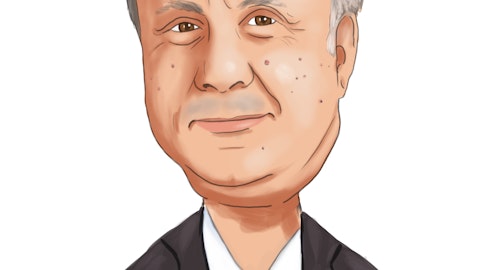So that translation is there. So the story is there. But right now, we are staying focused on sarcoidosis. Last thing I’ll say is, we are looking more closely at neuropilin expression in scleroderma patients. There’s anecdotal evidence that neuropilin is quite upregulated in some of those sclerodermatous plaques, but I think we have some time to look more closely at that. But certainly that is an opportunity that if we had abundant resources and infinite resources certainly is another large market opportunity sitting there for us.
Unidentified Participant: That’s great. Thank you very much.
Operator: One moment. And our next question will come from Joe Pantginis of H.C. Wainwright. Your line is open.
Joe Pantginis: Hey, everybody. Good afternoon. Thanks for taking the question. So first, just a little more on EFZO-FIT. Obviously, it’s early and just wanted to see, I’m not implying these are any rate limiting steps. We wanted to get your sort of early views on how you view the ease of screening patients and any particular geographies even in just the U.S. that you might see outperform even before the European sites come onboard?
Sanjay Shukla: Yeah. Hi, Joe. Great question. We’ve made some tweaks to our protocol based on our last study that I think are going to address some of your points here. Number one, moving into Europe and Japan, there tends to be slightly less — slightly less steroid administered in those patients. That could have to do with the physiology of those patients, but also there’s a larger cohort of African Americans of black patients here in the U.S., which typically those patients have more severe disease and may require more steroids. With that in mind, we’ve lowered the threshold in this current protocol to allow entry at 7.5 milligrams as opposed to 10. We think this is going to help us enroll and better fits the sort of treatment paradigm of Japan and Europe, where they tend to use a little bit less.
So I’ll start there and say that’s going to help us. I’ll also say that compared to the last study where PET scans were used as an inclusion criteria and have now fallen out of favor of five years later, we’re now using HRCT, which is going to be a little bit easier to administer and readout more commonly viewed as a better instrument to detect fibrotic patients or not. We want to exclude those patients that are highly fibrotic and bring those patients in that are inflamed. HRCT is — I would say a more validated instrument than PET scan. This is going to help us. So I think those are two early sort of tweaks that we’ve made in this protocol to allow for easier entry into our trial. And then the last thing I’ll say is, our data from the last study.
The fact that we showed steroid reduction and we are the first therapy to really ever show the ability to improve symptoms and lung function while reducing steroids. This is really important to patients. So now that there’s that experience from that last trial, patients are very, very interested in our therapy because we’re not just showing nominal improvement in one or two endpoints. It’s really all the endpoints and the one that care most about is, can I get off steroids or can this help me reduce my steroid burden. That’s going to be a real attractive asset for us as we think about enrolling worldwide.
Joe Pantginis: That’s helpful. Thanks. And then when you just look at the especially in this current environment, it’s glad to see you guys being thoughtful about your resources. So how would you describe, how much you’re putting your background overall NRP to work not on the back burner but just sort of pausing a little bit from a cash spend standpoint?





